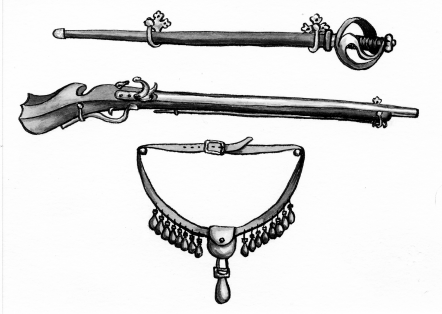

|
The following entry appears in a Witheridge estate notebook for 22 June 1716, but we do not know who wrote it. "Paid George Elworthy (Head of our fifty) the sum of fourteen shillings and seven pence for my share according to the poor rate towards a new stock and cleansing the musket, a new baggonett, a new cartridge box, a new scabbard and cleansing the sword, and a new belt".
The musket and sword must have been part of the parish armour and was the responsibility of the parish constable. Muskets and swords were typical of such equipment, which could also have included a pike, stockings, hats, coats, and body armour. For centuries, there was no regular or standing Army in England. If one was required, then it had to be raised specially. The method of doing this filtered down through counties, hundreds and parishes, all of which were organised to provide a militia when called upon. It was the constables job to see that when the call came, it was answered. He was also responsible for ensuring the parish arms were in good repair. He had general tasks to maintain law and order, and to see that the parish butts were kept in good order for shooting practice. Our Butts Close tells us where the local butts were once located. Why Witheridge's arms needed costly repair work in 1716 is a mystery. The wars with the French had ended in 1712, and the Jacobite rebellion in 1715 had not threatened the South West by land. However, in 1715, Parliament had called out the militia, and it is possible that Witheridge men were among those called upon. The word 'cleansing' in the above entry suggests that the musket and sword may well have been used. George Elworthy is referred to as 'Head of our fifty'. This may mean that the contingent from Witheridge hundred numbered 50. The parish constable evolved from the old manorial position of "headborough" or "tithingman" and his duties grew from being a simple keeper of the local peace to something more akin to that of a present day police officer. His duties would probably have included many, if not all, of the following.
After 1660, the parish constable was normally selected by the parish vestry, and, although it was legally the responsibility of the manor, the justices of the peace in fact confirmed court until 1842, his appointment. The duties of constable meant that he was responsible both to the secular authorities, and to the church authorities, and would have to appear not only at quarter sessions court or the assizes, but also at the church courts when the parish made its "presentments." Previous Last Edited 03/07/2006 Copyright © 2000-2006 Witheridge Unless otherwise indicated on the page in question, the photographic images reproduced on this site belong to the Witheridge Archives, and, as such may not be reproduced for commercial purposes without written permission. However, you are welcome to use any of the photographs belonging to the archive for personal and/or non-commercial use. Any material shown as not being owned by the archive may not be reproduced in any form without first receiving written permission from the owner of the material in question. The copyright for the illustration of the Parish Armour belongs to Witheridge Artist and Illustrator Jenny Bidgood. |


